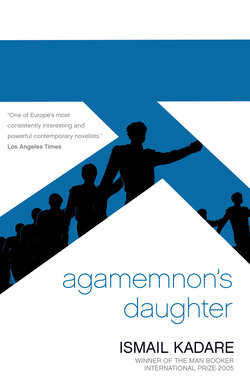Читать книгу Agamemnon's Daughter - Ismail Kadare - Страница 5
На сайте Литреса книга снята с продажи.
ABOUT AGAMEMNON’S DAUGHTER
ОглавлениеAdapted from the publisher’s preface to the French edition
In 1986, during one of his infrequent visits to Paris, Ismail Kadare told me that he wanted to leave the manuscripts of two short novels, a story, and some poems in France, as they could not be published in Albania at that time.
He had part of the material with him. “Exfiltration” of literary manuscripts was strictly forbidden under Albanian law, so Kadare camouflaged his text to make it look like an Albanian translation of a work written in the West. He had substituted German and Austrian names and places for Albanian ones, and attributed the works to the West German novelist Siegfried Lenz. Lenz was not unknown in Albania, but not to the extent that people could be sure whether he had written a novel called The Three Ks, as Kadare then entitled the novel subsequently known as L’Ombre (The Shadow).
Later on, Kadare managed to smuggle more of his manuscripts out of Albania, but because exfiltration remained extremely perilous, he limited his risks by bringing only a few pages on each trip. To get the remainder of the material out of the country, we agreed that the best way was for me to go to Tirana myself. Over two separate trips, I managed to bring all the remaining sheets back to Paris so as to have complete texts of The Shadow, Agamemnon’s Daughter, L’Envol du Migrateur (A Bird Flying South), and the poems.
The manuscripts were deposited in a safe at the Banque de la Cité in Paris. With the bank’s approval, Kadare entrusted me with the key to the safe and gave me authority to open it if and when I thought it necessary.
At that time Ismail Kadare had no greater inkling than anyone else that Albanian Communism would collapse. The deposit of these “dangerous” manuscripts was intended to allow Kadare’s publisher, in the event of the writer’s natural or “accidental” death, to declare that a previously unknown portion of his work would be published quickly. The revelation of the tone and content of the unpublished works would make it much harder for the Communist propaganda machine to bend Kadare’s work and posthumous image to its own ends.
The three prose texts and the poems put into the bank’s safe express directly and unambiguously what Kadare thought of the Albanian regime. Previously, he had touched on the matter only indirectly and by allusion, in works like The Palace of Dreams, La Niche de la honte (The Nook of Shame), and The Concert.
The first of these hidden works to appear in France was The Shadow, in 1994. It was rewritten to erase its German camouflage, especially noticeable in the earlier part of the novel. Editorial improvements were made to fill gaps that had been left quite intentionally when the work’s primary aim had been to get a message across — in the literal sense, across the border separating Albania from the rest of the world.
A Bird Flying South was published later. In Albania, it was published simultaneously in two versions — the original text as smuggled out of Albania and a corrected and edited version, the form in which Kadare wished it to return to Albania.
Agamemnon’s Daughter, the third of the manuscripts put into safekeeping, was published in France in 2003 in a translation by Tedi Papavrami from the text written in 1984–1986 without any later changes or revisions. Agamemnon’s Daughter is the first part of a diptych of which the longer tale, The Successor, was written in Paris in 2002. Taken together these two short novels constitute one of the finest and most accomplished of all Ismail Kadare’s works to date.
CLAUDE DURAND
PARIS
